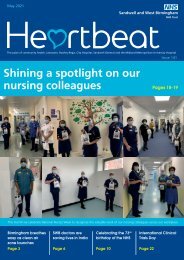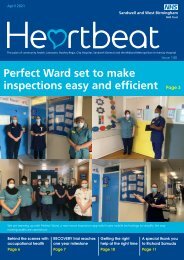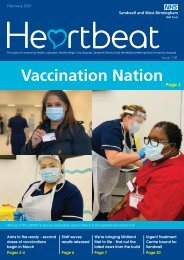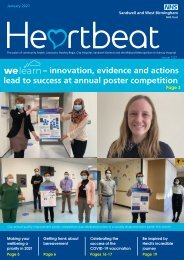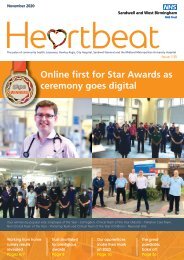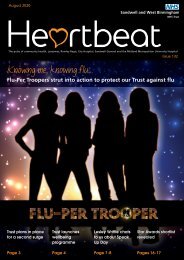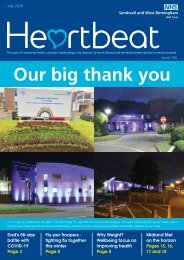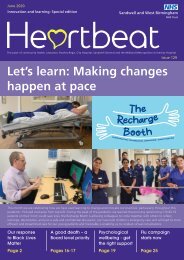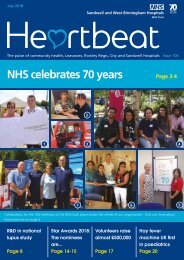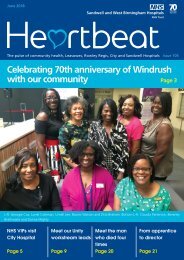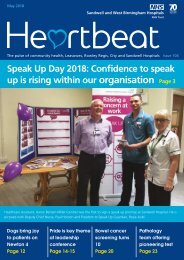Heartbeat March 2020
Create successful ePaper yourself
Turn your PDF publications into a flip-book with our unique Google optimized e-Paper software.
Inside the mortuary – taking care of<br />
our patients right to the end<br />
Jessica Arnold, Mortuary Service Manager is one of five colleagues who perform post-mortems at<br />
our Trust<br />
When many of us think of a mortuary<br />
we are filled with dread and fear often<br />
imagining what it must be like to be<br />
surrounded by death. However, when<br />
you meet our colleagues who work<br />
in the mortuary at City and Sandwell<br />
it is somewhat reassuring to see that<br />
the mortuary is a calm, even homely<br />
looking place aimed at making loved<br />
ones feel at ease during the most<br />
difficult time of their lives.<br />
<strong>Heartbeat</strong> caught up with our Mortuary<br />
Service Manager, Jessica Arnold who told<br />
us more. “People often have<br />
misconceptions about the mortuary and<br />
what we do – our aim is simple – patient<br />
care. We look after patients who have<br />
passed away and ensure they are taken care<br />
of until they leave for a burial or cremation.<br />
We can deal with very emotive cases<br />
but the team are here because they are<br />
compassionate and caring.”<br />
We asked Jessica to explain the flow of a<br />
patient leaving the ward and going into the<br />
care of the mortuary.<br />
She said: “When our patients are brought<br />
down by portering colleagues, part of our<br />
role is to check their paperwork is in order.<br />
We check that the patient has the correct<br />
ID and that all their personal belongings are<br />
accounted for. Patients are also measured as<br />
part of the requirement for the undertakers<br />
who require the measurements in order<br />
to prepare the coffins. There is a beautiful<br />
handwritten register where we write the<br />
patient’s name, date of death and the name<br />
of the undertaker. The information is also<br />
recorded electronically.”<br />
Five technicians make up the team in the<br />
mortuary who all take part in undertaking<br />
post mortems. Jessica explained that not all<br />
patients have a post mortem and it depends<br />
on whether the cause of death is known.<br />
“Post mortems are usually carried out if a<br />
patient dies unexpectedly,” said Jessica. “The<br />
process is meant to piece the puzzle of how<br />
someone died. Our coroner’s jurisdiction has<br />
access to a digital autopsy which is situated<br />
at Sandwell crematorium; it is a scanner that<br />
helps to ascertain the cause of death limiting<br />
the need for invasive procedures. In some<br />
cases the scan can be inconclusive so we have<br />
to carry out a full invasive post mortem.<br />
“As technicians we remove all the organs in<br />
preparation of dissection and examination by<br />
the pathologist. This can sometimes result in<br />
further examination where blood and urine is<br />
collected for further testing in the lab. Once<br />
it is clear how a patient has died, the coroner<br />
can issue the necessary paperwork for a<br />
funeral to take place.”<br />
It’s hard to imagine what it must be like<br />
having to deal with patients who have lost<br />
their lives and their families.<br />
Kulwinder Johal, Clinical Directorate Lead has<br />
recently taken on the overall management of<br />
the mortuary. She said: “Dealing with people<br />
in a bereaved status is very challenging. I am<br />
in awe of how the team take care of our<br />
patients as well as manage the expectations<br />
of loved ones.<br />
PRIMARY CARE, COMMUNITIES<br />
AND THERAPIES<br />
“They often have to have sensitive<br />
conversations with families to prepare<br />
them about what to expect when they<br />
see their loved one.”<br />
Jessica added: “We are not a funeral<br />
home so we are limited as to what we<br />
can do to prepare patients for viewing.<br />
But we do ensure that hair is brushed<br />
or combed and that the eyes and<br />
mouth are shut. The aim is to give the<br />
impression that the patient is sleeping<br />
so we lay them on a viewing trolley that<br />
looks like a bed.”<br />
Kulwinder aims to raise awareness of<br />
the mortuary service and the amazing<br />
work they do. “I don’t think colleagues<br />
around the organisation fully understand<br />
the work and skill that goes into caring<br />
for deceased patients,” she said. “We<br />
have just gone through a Human Tissues<br />
Authority (HTA) inspection and there<br />
is a lot of structure and accountability<br />
required to run a mortuary service.<br />
“We have worked together with our<br />
colleagues including clinical nurse<br />
practitioners, bereavement support<br />
midwives and ward managers as part<br />
of a stakeholder group involved with<br />
the deceased to achieve the standards<br />
of the HTA and deliver a coordinated<br />
approach to the way we care for<br />
deceased patients.<br />
“Together we work to ensure patients<br />
are laid to rest quicker and we also<br />
provide training particularly for the rapid<br />
release process. The rapid release process<br />
ensures that a death certificate is signed<br />
on the ward at the time of death (if<br />
cause is known). A signed form is issued<br />
to the family who will give authority for<br />
the body to be released. The patient is<br />
then escorted to the mortuary by a ward<br />
colleague and handed over straight to<br />
the undertaker. When done right, rapid<br />
release can take up to four hours and is<br />
a great comfort for families as they can<br />
lay their loved ones to rest.”<br />
Jessica commented: “Part of the work of<br />
the stakeholder group is also to ensure<br />
families are supported throughout the<br />
process and where necessary direct<br />
them to services that provide financial<br />
support.”<br />
If you would like further information<br />
or training please contact Jessica on<br />
jessica.arnold3@nhs.net<br />
25




